University Report: Public Health, Obesity, and Healthcare Strategies
VerifiedAdded on 2020/10/22
|15
|4384
|201
Report
AI Summary
This report delves into the public health issue of obesity, exploring its multifaceted dimensions. It begins with an introduction to the concept of public health and the escalating prevalence of obesity, particularly in the UK. The methodology outlines the literature search strategy, including key terms, databases, and boolean operators used to gather relevant information. The report then identifies and discusses three key themes: the impact of obesity on physical and psychological health, examining associated health risks and the rationale for addressing the issue; factors contributing to obesity, including genetics, unhealthy eating habits, and lifestyle; and the stigma associated with obesity and its impact on individuals. The report also includes a CRAP analysis of the literature reviewed and suggests service improvements. The conclusion summarizes the key findings and emphasizes the need for healthcare interventions to address obesity. The report highlights the role of nurses and healthcare professionals in providing care and support to those affected by obesity and aims to design strategies to improve the well being of communities.
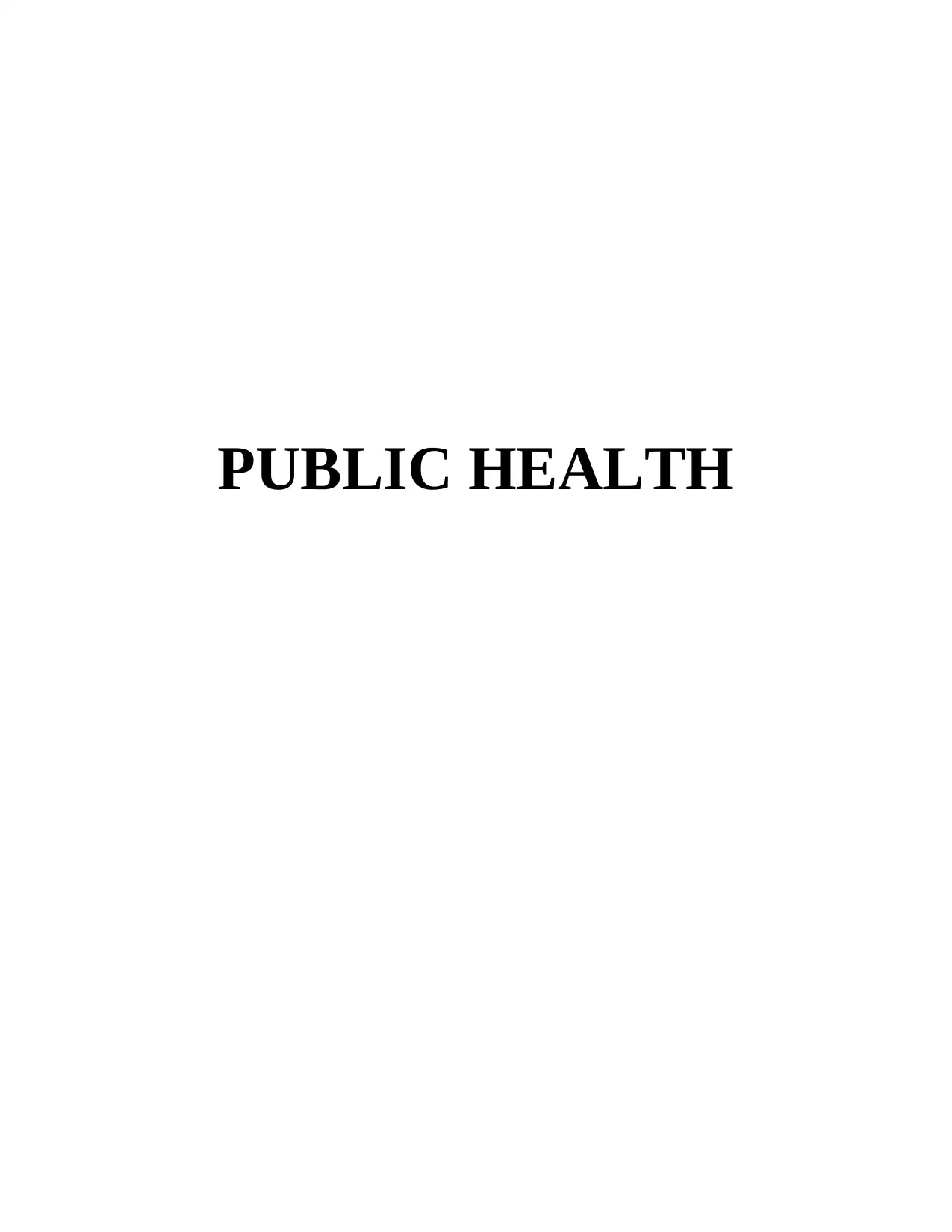
PUBLIC HEALTH
Paraphrase This Document
Need a fresh take? Get an instant paraphrase of this document with our AI Paraphraser
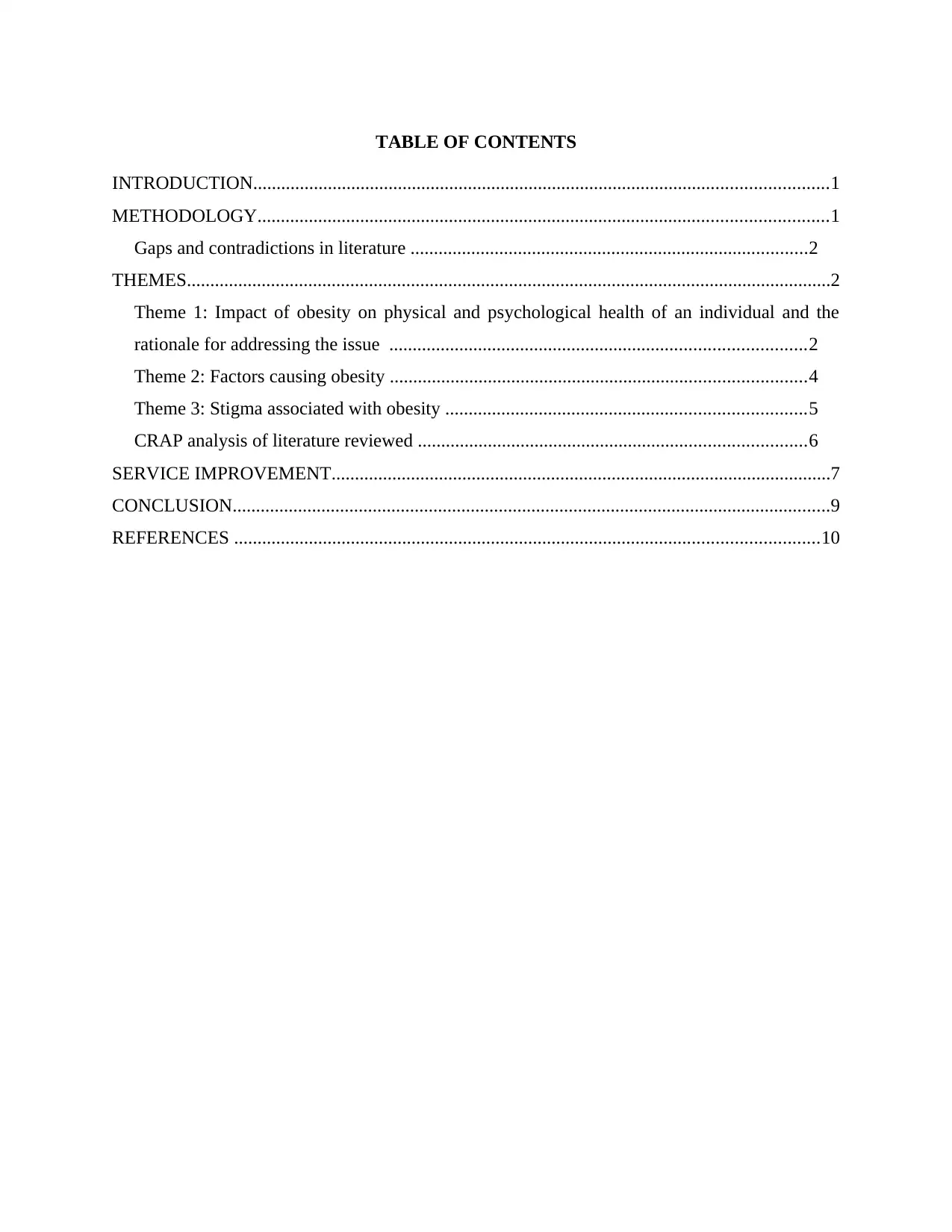
TABLE OF CONTENTS
INTRODUCTION...........................................................................................................................1
METHODOLOGY..........................................................................................................................1
Gaps and contradictions in literature .....................................................................................2
THEMES..........................................................................................................................................2
Theme 1: Impact of obesity on physical and psychological health of an individual and the
rationale for addressing the issue .........................................................................................2
Theme 2: Factors causing obesity .........................................................................................4
Theme 3: Stigma associated with obesity .............................................................................5
CRAP analysis of literature reviewed ...................................................................................6
SERVICE IMPROVEMENT...........................................................................................................7
CONCLUSION................................................................................................................................9
REFERENCES .............................................................................................................................10
INTRODUCTION...........................................................................................................................1
METHODOLOGY..........................................................................................................................1
Gaps and contradictions in literature .....................................................................................2
THEMES..........................................................................................................................................2
Theme 1: Impact of obesity on physical and psychological health of an individual and the
rationale for addressing the issue .........................................................................................2
Theme 2: Factors causing obesity .........................................................................................4
Theme 3: Stigma associated with obesity .............................................................................5
CRAP analysis of literature reviewed ...................................................................................6
SERVICE IMPROVEMENT...........................................................................................................7
CONCLUSION................................................................................................................................9
REFERENCES .............................................................................................................................10
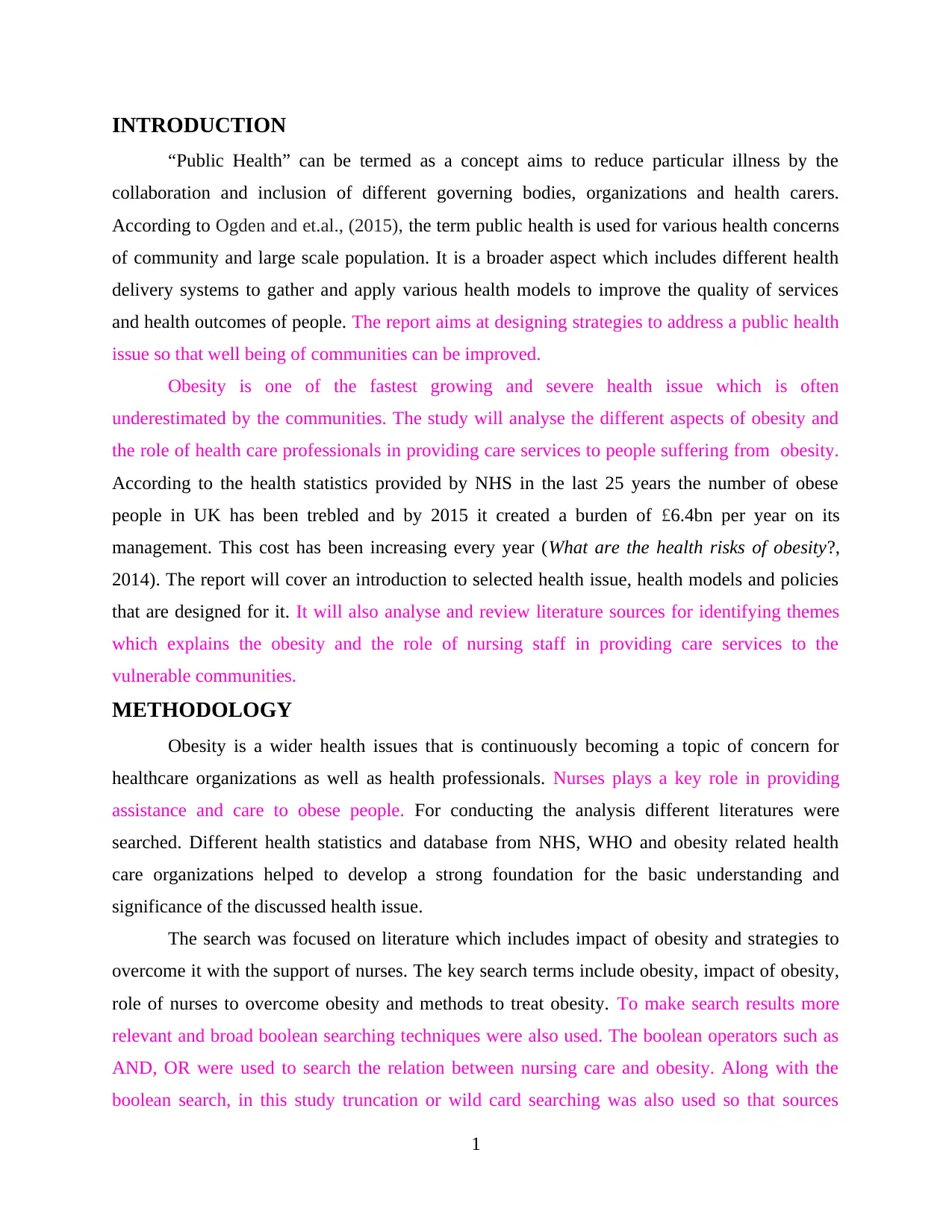
INTRODUCTION
“Public Health” can be termed as a concept aims to reduce particular illness by the
collaboration and inclusion of different governing bodies, organizations and health carers.
According to Ogden and et.al., (2015), the term public health is used for various health concerns
of community and large scale population. It is a broader aspect which includes different health
delivery systems to gather and apply various health models to improve the quality of services
and health outcomes of people. The report aims at designing strategies to address a public health
issue so that well being of communities can be improved.
Obesity is one of the fastest growing and severe health issue which is often
underestimated by the communities. The study will analyse the different aspects of obesity and
the role of health care professionals in providing care services to people suffering from obesity.
According to the health statistics provided by NHS in the last 25 years the number of obese
people in UK has been trebled and by 2015 it created a burden of £6.4bn per year on its
management. This cost has been increasing every year (What are the health risks of obesity?,
2014). The report will cover an introduction to selected health issue, health models and policies
that are designed for it. It will also analyse and review literature sources for identifying themes
which explains the obesity and the role of nursing staff in providing care services to the
vulnerable communities.
METHODOLOGY
Obesity is a wider health issues that is continuously becoming a topic of concern for
healthcare organizations as well as health professionals. Nurses plays a key role in providing
assistance and care to obese people. For conducting the analysis different literatures were
searched. Different health statistics and database from NHS, WHO and obesity related health
care organizations helped to develop a strong foundation for the basic understanding and
significance of the discussed health issue.
The search was focused on literature which includes impact of obesity and strategies to
overcome it with the support of nurses. The key search terms include obesity, impact of obesity,
role of nurses to overcome obesity and methods to treat obesity. To make search results more
relevant and broad boolean searching techniques were also used. The boolean operators such as
AND, OR were used to search the relation between nursing care and obesity. Along with the
boolean search, in this study truncation or wild card searching was also used so that sources
1
“Public Health” can be termed as a concept aims to reduce particular illness by the
collaboration and inclusion of different governing bodies, organizations and health carers.
According to Ogden and et.al., (2015), the term public health is used for various health concerns
of community and large scale population. It is a broader aspect which includes different health
delivery systems to gather and apply various health models to improve the quality of services
and health outcomes of people. The report aims at designing strategies to address a public health
issue so that well being of communities can be improved.
Obesity is one of the fastest growing and severe health issue which is often
underestimated by the communities. The study will analyse the different aspects of obesity and
the role of health care professionals in providing care services to people suffering from obesity.
According to the health statistics provided by NHS in the last 25 years the number of obese
people in UK has been trebled and by 2015 it created a burden of £6.4bn per year on its
management. This cost has been increasing every year (What are the health risks of obesity?,
2014). The report will cover an introduction to selected health issue, health models and policies
that are designed for it. It will also analyse and review literature sources for identifying themes
which explains the obesity and the role of nursing staff in providing care services to the
vulnerable communities.
METHODOLOGY
Obesity is a wider health issues that is continuously becoming a topic of concern for
healthcare organizations as well as health professionals. Nurses plays a key role in providing
assistance and care to obese people. For conducting the analysis different literatures were
searched. Different health statistics and database from NHS, WHO and obesity related health
care organizations helped to develop a strong foundation for the basic understanding and
significance of the discussed health issue.
The search was focused on literature which includes impact of obesity and strategies to
overcome it with the support of nurses. The key search terms include obesity, impact of obesity,
role of nurses to overcome obesity and methods to treat obesity. To make search results more
relevant and broad boolean searching techniques were also used. The boolean operators such as
AND, OR were used to search the relation between nursing care and obesity. Along with the
boolean search, in this study truncation or wild card searching was also used so that sources
1
⊘ This is a preview!⊘
Do you want full access?
Subscribe today to unlock all pages.

Trusted by 1+ million students worldwide
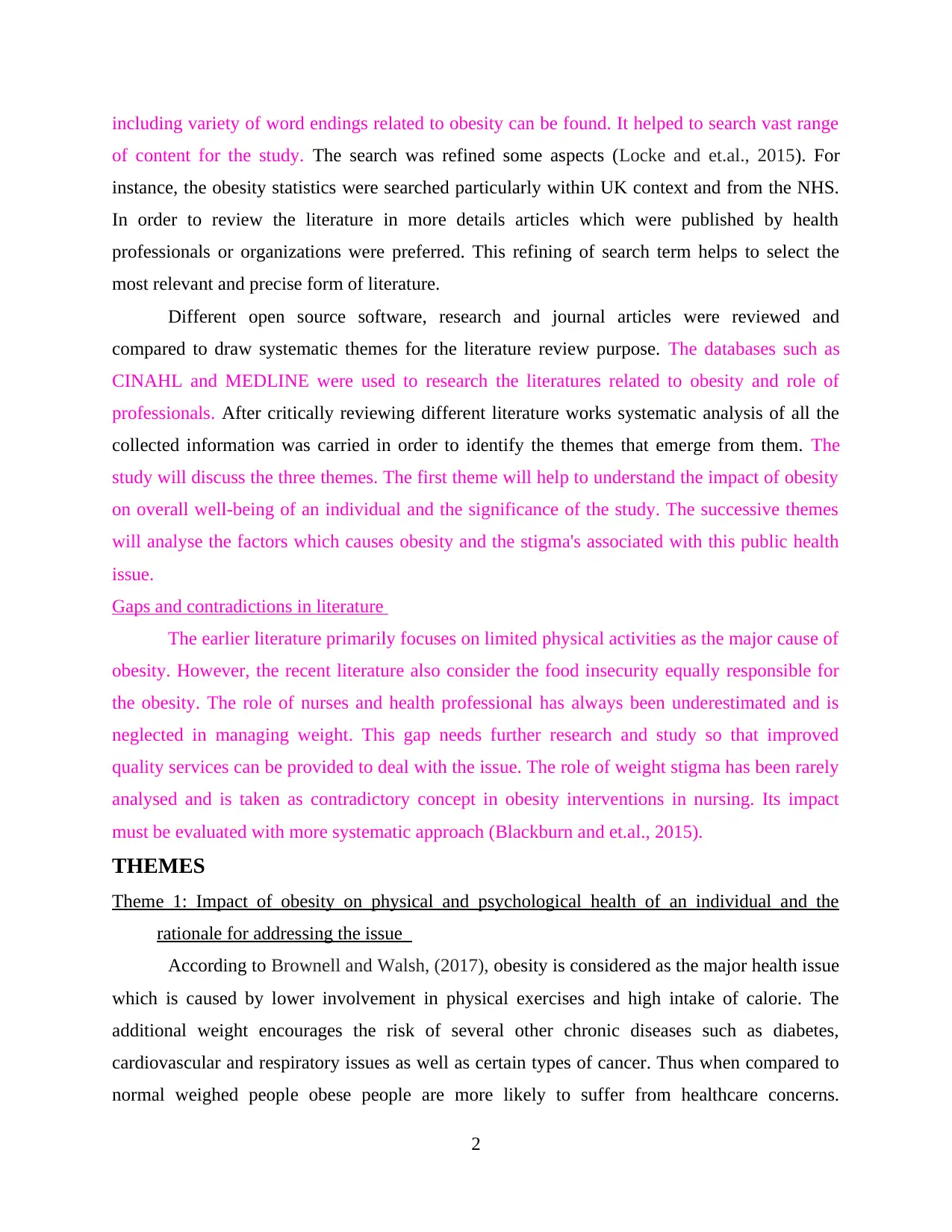
including variety of word endings related to obesity can be found. It helped to search vast range
of content for the study. The search was refined some aspects (Locke and et.al., 2015). For
instance, the obesity statistics were searched particularly within UK context and from the NHS.
In order to review the literature in more details articles which were published by health
professionals or organizations were preferred. This refining of search term helps to select the
most relevant and precise form of literature.
Different open source software, research and journal articles were reviewed and
compared to draw systematic themes for the literature review purpose. The databases such as
CINAHL and MEDLINE were used to research the literatures related to obesity and role of
professionals. After critically reviewing different literature works systematic analysis of all the
collected information was carried in order to identify the themes that emerge from them. The
study will discuss the three themes. The first theme will help to understand the impact of obesity
on overall well-being of an individual and the significance of the study. The successive themes
will analyse the factors which causes obesity and the stigma's associated with this public health
issue.
Gaps and contradictions in literature
The earlier literature primarily focuses on limited physical activities as the major cause of
obesity. However, the recent literature also consider the food insecurity equally responsible for
the obesity. The role of nurses and health professional has always been underestimated and is
neglected in managing weight. This gap needs further research and study so that improved
quality services can be provided to deal with the issue. The role of weight stigma has been rarely
analysed and is taken as contradictory concept in obesity interventions in nursing. Its impact
must be evaluated with more systematic approach (Blackburn and et.al., 2015).
THEMES
Theme 1: Impact of obesity on physical and psychological health of an individual and the
rationale for addressing the issue
According to Brownell and Walsh, (2017), obesity is considered as the major health issue
which is caused by lower involvement in physical exercises and high intake of calorie. The
additional weight encourages the risk of several other chronic diseases such as diabetes,
cardiovascular and respiratory issues as well as certain types of cancer. Thus when compared to
normal weighed people obese people are more likely to suffer from healthcare concerns.
2
of content for the study. The search was refined some aspects (Locke and et.al., 2015). For
instance, the obesity statistics were searched particularly within UK context and from the NHS.
In order to review the literature in more details articles which were published by health
professionals or organizations were preferred. This refining of search term helps to select the
most relevant and precise form of literature.
Different open source software, research and journal articles were reviewed and
compared to draw systematic themes for the literature review purpose. The databases such as
CINAHL and MEDLINE were used to research the literatures related to obesity and role of
professionals. After critically reviewing different literature works systematic analysis of all the
collected information was carried in order to identify the themes that emerge from them. The
study will discuss the three themes. The first theme will help to understand the impact of obesity
on overall well-being of an individual and the significance of the study. The successive themes
will analyse the factors which causes obesity and the stigma's associated with this public health
issue.
Gaps and contradictions in literature
The earlier literature primarily focuses on limited physical activities as the major cause of
obesity. However, the recent literature also consider the food insecurity equally responsible for
the obesity. The role of nurses and health professional has always been underestimated and is
neglected in managing weight. This gap needs further research and study so that improved
quality services can be provided to deal with the issue. The role of weight stigma has been rarely
analysed and is taken as contradictory concept in obesity interventions in nursing. Its impact
must be evaluated with more systematic approach (Blackburn and et.al., 2015).
THEMES
Theme 1: Impact of obesity on physical and psychological health of an individual and the
rationale for addressing the issue
According to Brownell and Walsh, (2017), obesity is considered as the major health issue
which is caused by lower involvement in physical exercises and high intake of calorie. The
additional weight encourages the risk of several other chronic diseases such as diabetes,
cardiovascular and respiratory issues as well as certain types of cancer. Thus when compared to
normal weighed people obese people are more likely to suffer from healthcare concerns.
2
Paraphrase This Document
Need a fresh take? Get an instant paraphrase of this document with our AI Paraphraser
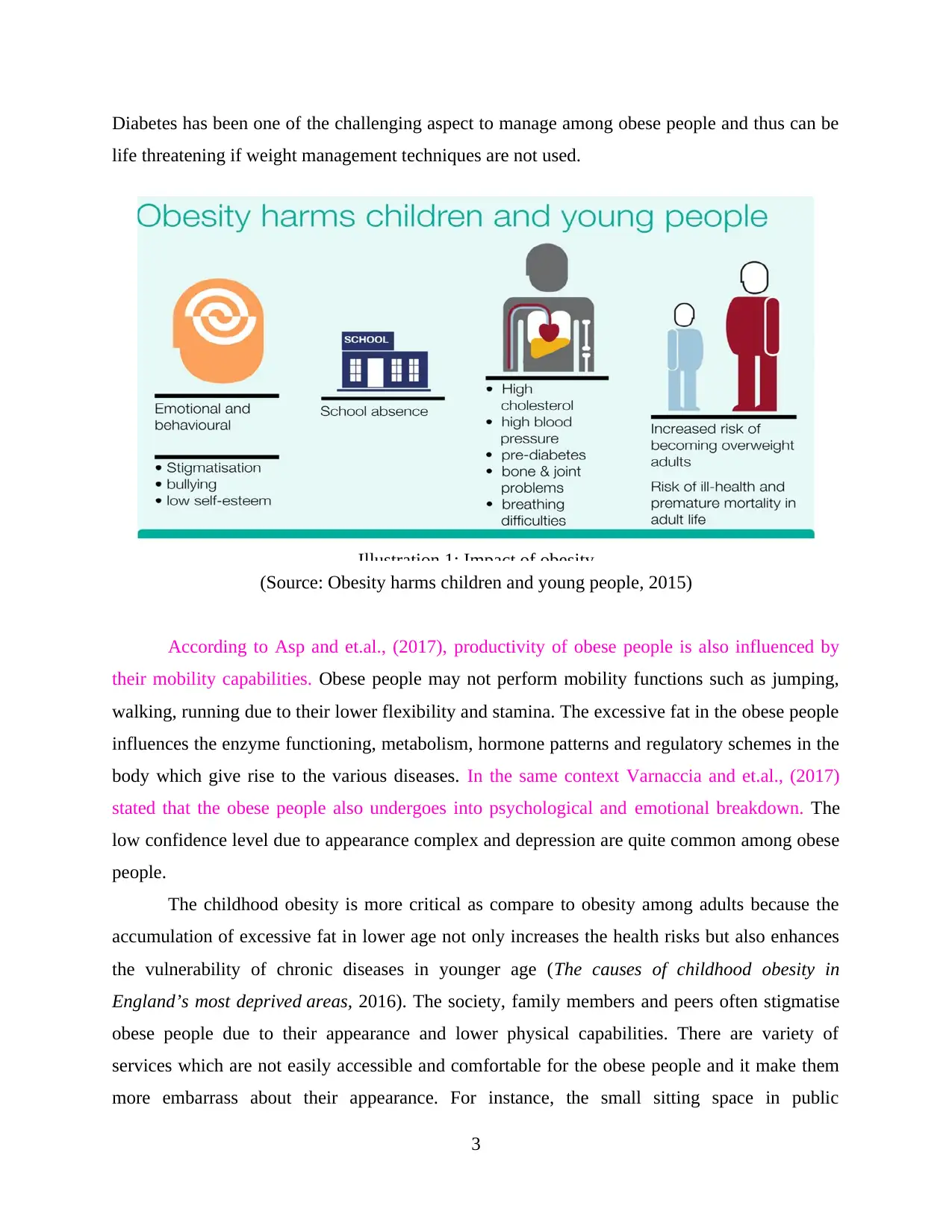
Diabetes has been one of the challenging aspect to manage among obese people and thus can be
life threatening if weight management techniques are not used.
(Source: Obesity harms children and young people, 2015)
According to Asp and et.al., (2017), productivity of obese people is also influenced by
their mobility capabilities. Obese people may not perform mobility functions such as jumping,
walking, running due to their lower flexibility and stamina. The excessive fat in the obese people
influences the enzyme functioning, metabolism, hormone patterns and regulatory schemes in the
body which give rise to the various diseases. In the same context Varnaccia and et.al., (2017)
stated that the obese people also undergoes into psychological and emotional breakdown. The
low confidence level due to appearance complex and depression are quite common among obese
people.
The childhood obesity is more critical as compare to obesity among adults because the
accumulation of excessive fat in lower age not only increases the health risks but also enhances
the vulnerability of chronic diseases in younger age (The causes of childhood obesity in
England’s most deprived areas, 2016). The society, family members and peers often stigmatise
obese people due to their appearance and lower physical capabilities. There are variety of
services which are not easily accessible and comfortable for the obese people and it make them
more embarrass about their appearance. For instance, the small sitting space in public
3
Illustration 1: Impact of obesity
life threatening if weight management techniques are not used.
(Source: Obesity harms children and young people, 2015)
According to Asp and et.al., (2017), productivity of obese people is also influenced by
their mobility capabilities. Obese people may not perform mobility functions such as jumping,
walking, running due to their lower flexibility and stamina. The excessive fat in the obese people
influences the enzyme functioning, metabolism, hormone patterns and regulatory schemes in the
body which give rise to the various diseases. In the same context Varnaccia and et.al., (2017)
stated that the obese people also undergoes into psychological and emotional breakdown. The
low confidence level due to appearance complex and depression are quite common among obese
people.
The childhood obesity is more critical as compare to obesity among adults because the
accumulation of excessive fat in lower age not only increases the health risks but also enhances
the vulnerability of chronic diseases in younger age (The causes of childhood obesity in
England’s most deprived areas, 2016). The society, family members and peers often stigmatise
obese people due to their appearance and lower physical capabilities. There are variety of
services which are not easily accessible and comfortable for the obese people and it make them
more embarrass about their appearance. For instance, the small sitting space in public
3
Illustration 1: Impact of obesity
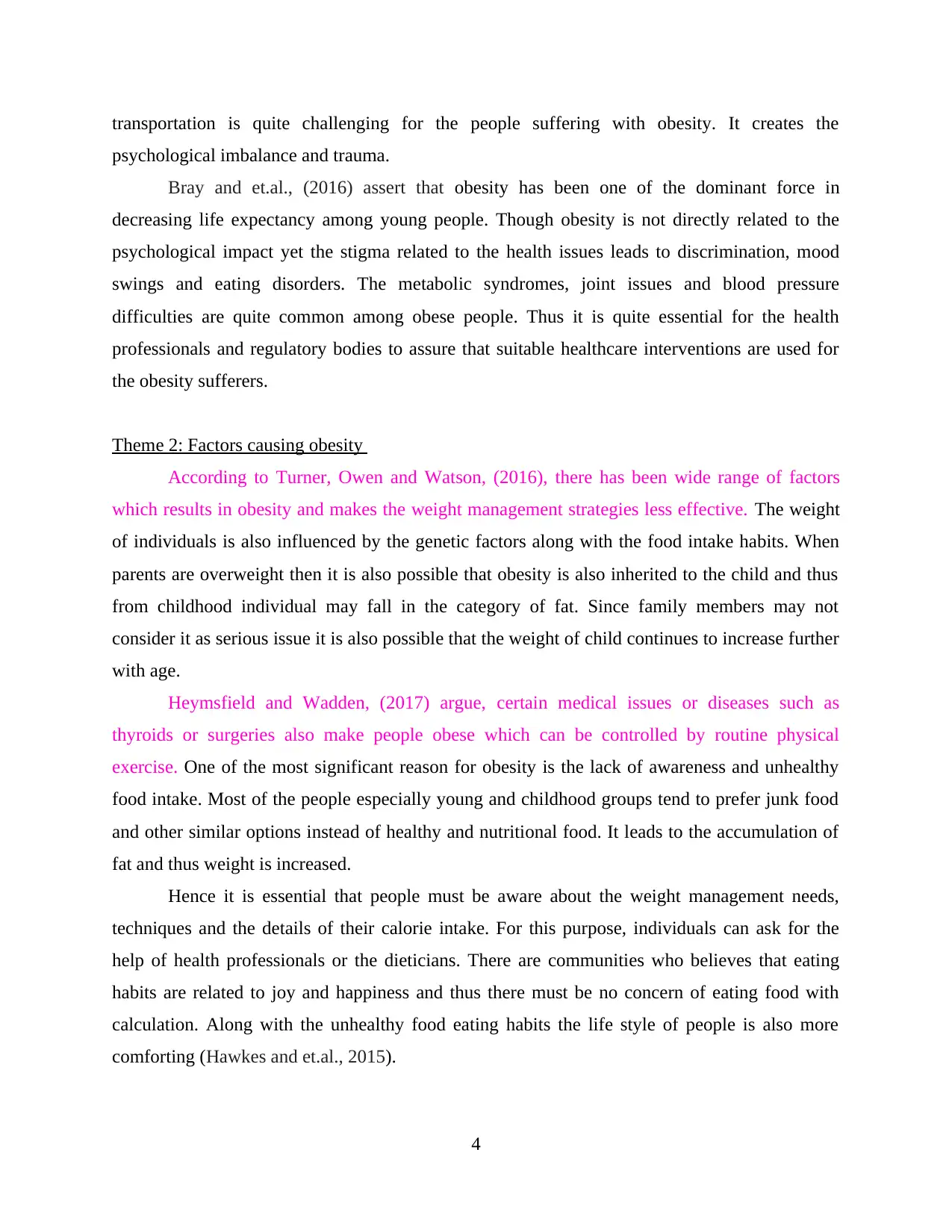
transportation is quite challenging for the people suffering with obesity. It creates the
psychological imbalance and trauma.
Bray and et.al., (2016) assert that obesity has been one of the dominant force in
decreasing life expectancy among young people. Though obesity is not directly related to the
psychological impact yet the stigma related to the health issues leads to discrimination, mood
swings and eating disorders. The metabolic syndromes, joint issues and blood pressure
difficulties are quite common among obese people. Thus it is quite essential for the health
professionals and regulatory bodies to assure that suitable healthcare interventions are used for
the obesity sufferers.
Theme 2: Factors causing obesity
According to Turner, Owen and Watson, (2016), there has been wide range of factors
which results in obesity and makes the weight management strategies less effective. The weight
of individuals is also influenced by the genetic factors along with the food intake habits. When
parents are overweight then it is also possible that obesity is also inherited to the child and thus
from childhood individual may fall in the category of fat. Since family members may not
consider it as serious issue it is also possible that the weight of child continues to increase further
with age.
Heymsfield and Wadden, (2017) argue, certain medical issues or diseases such as
thyroids or surgeries also make people obese which can be controlled by routine physical
exercise. One of the most significant reason for obesity is the lack of awareness and unhealthy
food intake. Most of the people especially young and childhood groups tend to prefer junk food
and other similar options instead of healthy and nutritional food. It leads to the accumulation of
fat and thus weight is increased.
Hence it is essential that people must be aware about the weight management needs,
techniques and the details of their calorie intake. For this purpose, individuals can ask for the
help of health professionals or the dieticians. There are communities who believes that eating
habits are related to joy and happiness and thus there must be no concern of eating food with
calculation. Along with the unhealthy food eating habits the life style of people is also more
comforting (Hawkes and et.al., 2015).
4
psychological imbalance and trauma.
Bray and et.al., (2016) assert that obesity has been one of the dominant force in
decreasing life expectancy among young people. Though obesity is not directly related to the
psychological impact yet the stigma related to the health issues leads to discrimination, mood
swings and eating disorders. The metabolic syndromes, joint issues and blood pressure
difficulties are quite common among obese people. Thus it is quite essential for the health
professionals and regulatory bodies to assure that suitable healthcare interventions are used for
the obesity sufferers.
Theme 2: Factors causing obesity
According to Turner, Owen and Watson, (2016), there has been wide range of factors
which results in obesity and makes the weight management strategies less effective. The weight
of individuals is also influenced by the genetic factors along with the food intake habits. When
parents are overweight then it is also possible that obesity is also inherited to the child and thus
from childhood individual may fall in the category of fat. Since family members may not
consider it as serious issue it is also possible that the weight of child continues to increase further
with age.
Heymsfield and Wadden, (2017) argue, certain medical issues or diseases such as
thyroids or surgeries also make people obese which can be controlled by routine physical
exercise. One of the most significant reason for obesity is the lack of awareness and unhealthy
food intake. Most of the people especially young and childhood groups tend to prefer junk food
and other similar options instead of healthy and nutritional food. It leads to the accumulation of
fat and thus weight is increased.
Hence it is essential that people must be aware about the weight management needs,
techniques and the details of their calorie intake. For this purpose, individuals can ask for the
help of health professionals or the dieticians. There are communities who believes that eating
habits are related to joy and happiness and thus there must be no concern of eating food with
calculation. Along with the unhealthy food eating habits the life style of people is also more
comforting (Hawkes and et.al., 2015).
4
⊘ This is a preview!⊘
Do you want full access?
Subscribe today to unlock all pages.

Trusted by 1+ million students worldwide
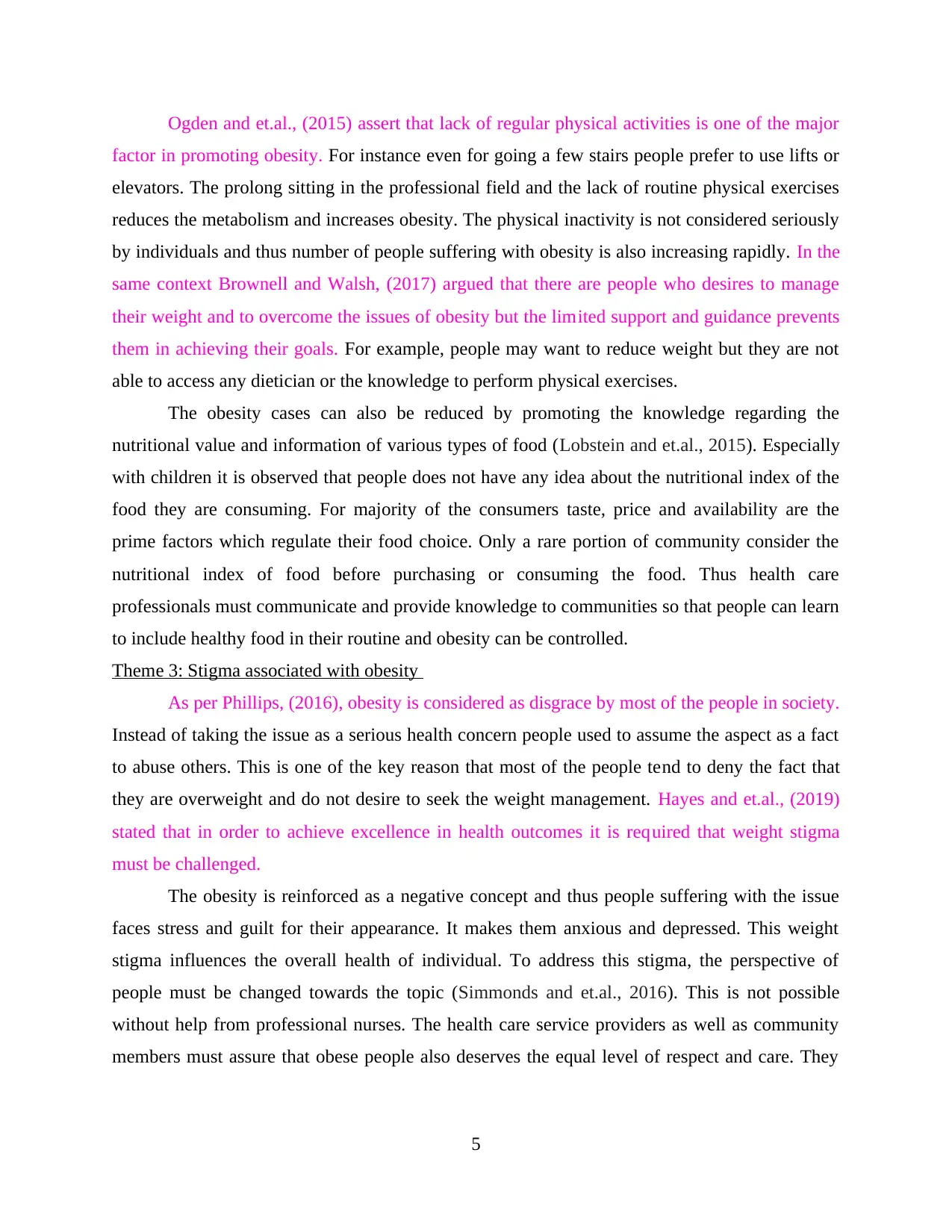
Ogden and et.al., (2015) assert that lack of regular physical activities is one of the major
factor in promoting obesity. For instance even for going a few stairs people prefer to use lifts or
elevators. The prolong sitting in the professional field and the lack of routine physical exercises
reduces the metabolism and increases obesity. The physical inactivity is not considered seriously
by individuals and thus number of people suffering with obesity is also increasing rapidly. In the
same context Brownell and Walsh, (2017) argued that there are people who desires to manage
their weight and to overcome the issues of obesity but the limited support and guidance prevents
them in achieving their goals. For example, people may want to reduce weight but they are not
able to access any dietician or the knowledge to perform physical exercises.
The obesity cases can also be reduced by promoting the knowledge regarding the
nutritional value and information of various types of food (Lobstein and et.al., 2015). Especially
with children it is observed that people does not have any idea about the nutritional index of the
food they are consuming. For majority of the consumers taste, price and availability are the
prime factors which regulate their food choice. Only a rare portion of community consider the
nutritional index of food before purchasing or consuming the food. Thus health care
professionals must communicate and provide knowledge to communities so that people can learn
to include healthy food in their routine and obesity can be controlled.
Theme 3: Stigma associated with obesity
As per Phillips, (2016), obesity is considered as disgrace by most of the people in society.
Instead of taking the issue as a serious health concern people used to assume the aspect as a fact
to abuse others. This is one of the key reason that most of the people tend to deny the fact that
they are overweight and do not desire to seek the weight management. Hayes and et.al., (2019)
stated that in order to achieve excellence in health outcomes it is required that weight stigma
must be challenged.
The obesity is reinforced as a negative concept and thus people suffering with the issue
faces stress and guilt for their appearance. It makes them anxious and depressed. This weight
stigma influences the overall health of individual. To address this stigma, the perspective of
people must be changed towards the topic (Simmonds and et.al., 2016). This is not possible
without help from professional nurses. The health care service providers as well as community
members must assure that obese people also deserves the equal level of respect and care. They
5
factor in promoting obesity. For instance even for going a few stairs people prefer to use lifts or
elevators. The prolong sitting in the professional field and the lack of routine physical exercises
reduces the metabolism and increases obesity. The physical inactivity is not considered seriously
by individuals and thus number of people suffering with obesity is also increasing rapidly. In the
same context Brownell and Walsh, (2017) argued that there are people who desires to manage
their weight and to overcome the issues of obesity but the limited support and guidance prevents
them in achieving their goals. For example, people may want to reduce weight but they are not
able to access any dietician or the knowledge to perform physical exercises.
The obesity cases can also be reduced by promoting the knowledge regarding the
nutritional value and information of various types of food (Lobstein and et.al., 2015). Especially
with children it is observed that people does not have any idea about the nutritional index of the
food they are consuming. For majority of the consumers taste, price and availability are the
prime factors which regulate their food choice. Only a rare portion of community consider the
nutritional index of food before purchasing or consuming the food. Thus health care
professionals must communicate and provide knowledge to communities so that people can learn
to include healthy food in their routine and obesity can be controlled.
Theme 3: Stigma associated with obesity
As per Phillips, (2016), obesity is considered as disgrace by most of the people in society.
Instead of taking the issue as a serious health concern people used to assume the aspect as a fact
to abuse others. This is one of the key reason that most of the people tend to deny the fact that
they are overweight and do not desire to seek the weight management. Hayes and et.al., (2019)
stated that in order to achieve excellence in health outcomes it is required that weight stigma
must be challenged.
The obesity is reinforced as a negative concept and thus people suffering with the issue
faces stress and guilt for their appearance. It makes them anxious and depressed. This weight
stigma influences the overall health of individual. To address this stigma, the perspective of
people must be changed towards the topic (Simmonds and et.al., 2016). This is not possible
without help from professional nurses. The health care service providers as well as community
members must assure that obese people also deserves the equal level of respect and care. They
5
Paraphrase This Document
Need a fresh take? Get an instant paraphrase of this document with our AI Paraphraser
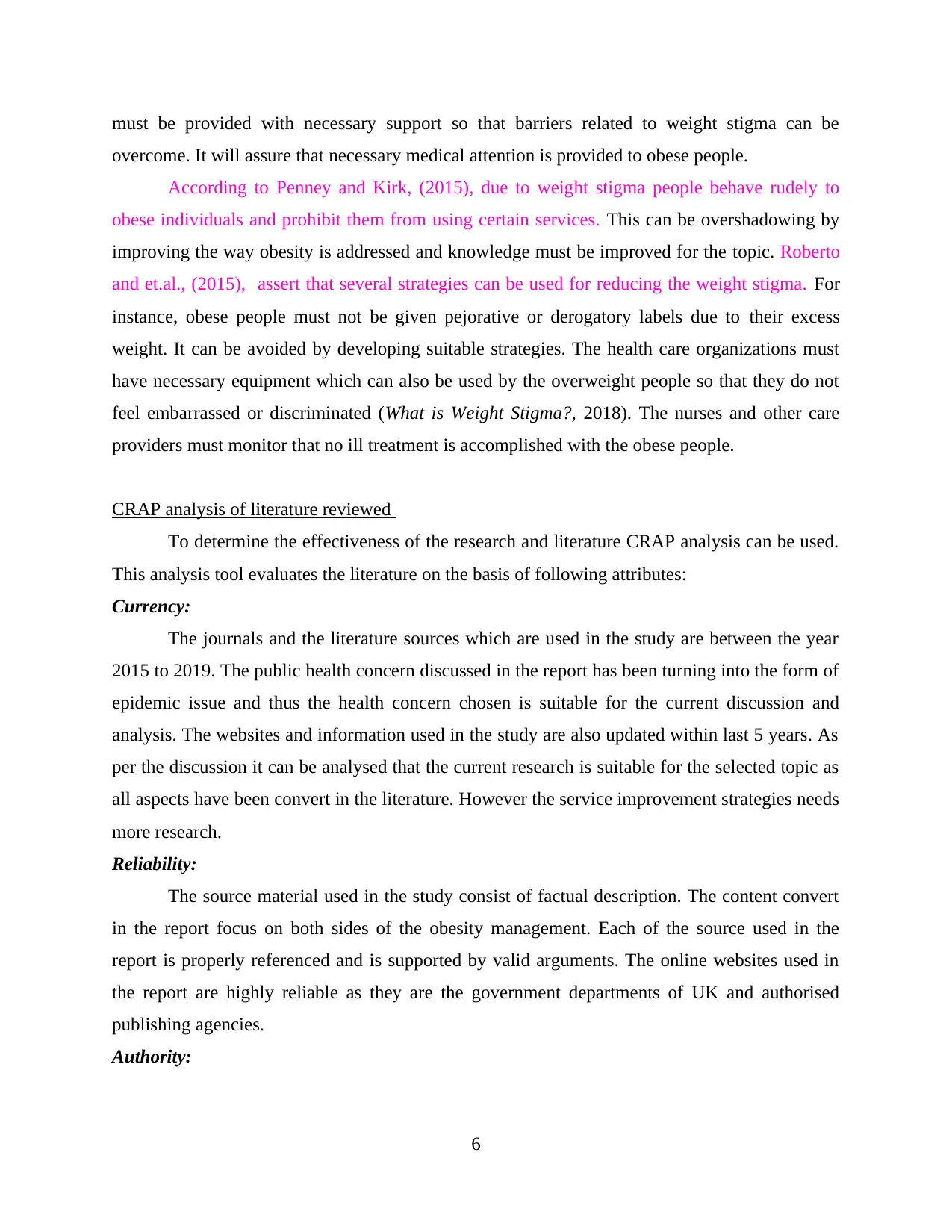
must be provided with necessary support so that barriers related to weight stigma can be
overcome. It will assure that necessary medical attention is provided to obese people.
According to Penney and Kirk, (2015), due to weight stigma people behave rudely to
obese individuals and prohibit them from using certain services. This can be overshadowing by
improving the way obesity is addressed and knowledge must be improved for the topic. Roberto
and et.al., (2015), assert that several strategies can be used for reducing the weight stigma. For
instance, obese people must not be given pejorative or derogatory labels due to their excess
weight. It can be avoided by developing suitable strategies. The health care organizations must
have necessary equipment which can also be used by the overweight people so that they do not
feel embarrassed or discriminated (What is Weight Stigma?, 2018). The nurses and other care
providers must monitor that no ill treatment is accomplished with the obese people.
CRAP analysis of literature reviewed
To determine the effectiveness of the research and literature CRAP analysis can be used.
This analysis tool evaluates the literature on the basis of following attributes:
Currency:
The journals and the literature sources which are used in the study are between the year
2015 to 2019. The public health concern discussed in the report has been turning into the form of
epidemic issue and thus the health concern chosen is suitable for the current discussion and
analysis. The websites and information used in the study are also updated within last 5 years. As
per the discussion it can be analysed that the current research is suitable for the selected topic as
all aspects have been convert in the literature. However the service improvement strategies needs
more research.
Reliability:
The source material used in the study consist of factual description. The content convert
in the report focus on both sides of the obesity management. Each of the source used in the
report is properly referenced and is supported by valid arguments. The online websites used in
the report are highly reliable as they are the government departments of UK and authorised
publishing agencies.
Authority:
6
overcome. It will assure that necessary medical attention is provided to obese people.
According to Penney and Kirk, (2015), due to weight stigma people behave rudely to
obese individuals and prohibit them from using certain services. This can be overshadowing by
improving the way obesity is addressed and knowledge must be improved for the topic. Roberto
and et.al., (2015), assert that several strategies can be used for reducing the weight stigma. For
instance, obese people must not be given pejorative or derogatory labels due to their excess
weight. It can be avoided by developing suitable strategies. The health care organizations must
have necessary equipment which can also be used by the overweight people so that they do not
feel embarrassed or discriminated (What is Weight Stigma?, 2018). The nurses and other care
providers must monitor that no ill treatment is accomplished with the obese people.
CRAP analysis of literature reviewed
To determine the effectiveness of the research and literature CRAP analysis can be used.
This analysis tool evaluates the literature on the basis of following attributes:
Currency:
The journals and the literature sources which are used in the study are between the year
2015 to 2019. The public health concern discussed in the report has been turning into the form of
epidemic issue and thus the health concern chosen is suitable for the current discussion and
analysis. The websites and information used in the study are also updated within last 5 years. As
per the discussion it can be analysed that the current research is suitable for the selected topic as
all aspects have been convert in the literature. However the service improvement strategies needs
more research.
Reliability:
The source material used in the study consist of factual description. The content convert
in the report focus on both sides of the obesity management. Each of the source used in the
report is properly referenced and is supported by valid arguments. The online websites used in
the report are highly reliable as they are the government departments of UK and authorised
publishing agencies.
Authority:
6
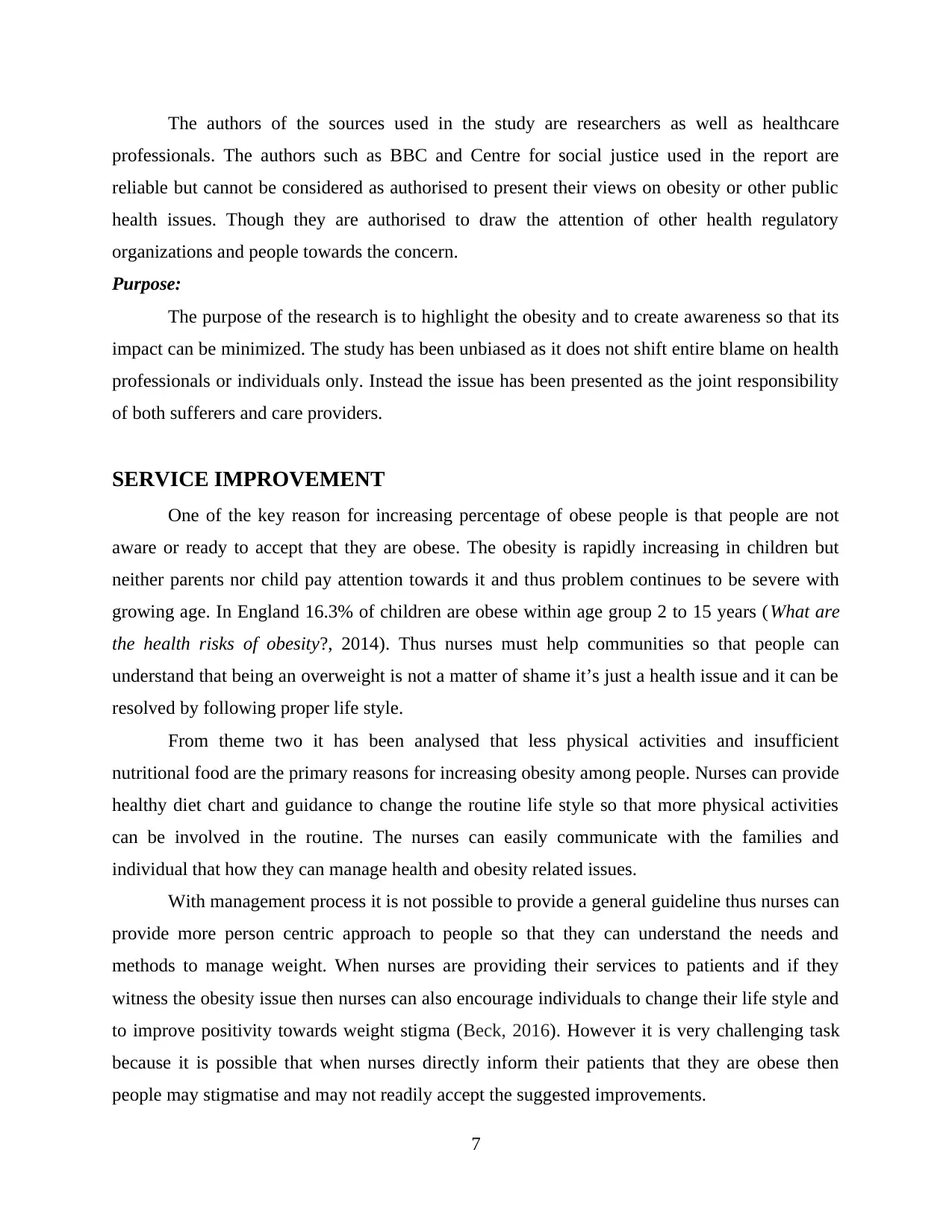
The authors of the sources used in the study are researchers as well as healthcare
professionals. The authors such as BBC and Centre for social justice used in the report are
reliable but cannot be considered as authorised to present their views on obesity or other public
health issues. Though they are authorised to draw the attention of other health regulatory
organizations and people towards the concern.
Purpose:
The purpose of the research is to highlight the obesity and to create awareness so that its
impact can be minimized. The study has been unbiased as it does not shift entire blame on health
professionals or individuals only. Instead the issue has been presented as the joint responsibility
of both sufferers and care providers.
SERVICE IMPROVEMENT
One of the key reason for increasing percentage of obese people is that people are not
aware or ready to accept that they are obese. The obesity is rapidly increasing in children but
neither parents nor child pay attention towards it and thus problem continues to be severe with
growing age. In England 16.3% of children are obese within age group 2 to 15 years (What are
the health risks of obesity?, 2014). Thus nurses must help communities so that people can
understand that being an overweight is not a matter of shame it’s just a health issue and it can be
resolved by following proper life style.
From theme two it has been analysed that less physical activities and insufficient
nutritional food are the primary reasons for increasing obesity among people. Nurses can provide
healthy diet chart and guidance to change the routine life style so that more physical activities
can be involved in the routine. The nurses can easily communicate with the families and
individual that how they can manage health and obesity related issues.
With management process it is not possible to provide a general guideline thus nurses can
provide more person centric approach to people so that they can understand the needs and
methods to manage weight. When nurses are providing their services to patients and if they
witness the obesity issue then nurses can also encourage individuals to change their life style and
to improve positivity towards weight stigma (Beck, 2016). However it is very challenging task
because it is possible that when nurses directly inform their patients that they are obese then
people may stigmatise and may not readily accept the suggested improvements.
7
professionals. The authors such as BBC and Centre for social justice used in the report are
reliable but cannot be considered as authorised to present their views on obesity or other public
health issues. Though they are authorised to draw the attention of other health regulatory
organizations and people towards the concern.
Purpose:
The purpose of the research is to highlight the obesity and to create awareness so that its
impact can be minimized. The study has been unbiased as it does not shift entire blame on health
professionals or individuals only. Instead the issue has been presented as the joint responsibility
of both sufferers and care providers.
SERVICE IMPROVEMENT
One of the key reason for increasing percentage of obese people is that people are not
aware or ready to accept that they are obese. The obesity is rapidly increasing in children but
neither parents nor child pay attention towards it and thus problem continues to be severe with
growing age. In England 16.3% of children are obese within age group 2 to 15 years (What are
the health risks of obesity?, 2014). Thus nurses must help communities so that people can
understand that being an overweight is not a matter of shame it’s just a health issue and it can be
resolved by following proper life style.
From theme two it has been analysed that less physical activities and insufficient
nutritional food are the primary reasons for increasing obesity among people. Nurses can provide
healthy diet chart and guidance to change the routine life style so that more physical activities
can be involved in the routine. The nurses can easily communicate with the families and
individual that how they can manage health and obesity related issues.
With management process it is not possible to provide a general guideline thus nurses can
provide more person centric approach to people so that they can understand the needs and
methods to manage weight. When nurses are providing their services to patients and if they
witness the obesity issue then nurses can also encourage individuals to change their life style and
to improve positivity towards weight stigma (Beck, 2016). However it is very challenging task
because it is possible that when nurses directly inform their patients that they are obese then
people may stigmatise and may not readily accept the suggested improvements.
7
⊘ This is a preview!⊘
Do you want full access?
Subscribe today to unlock all pages.

Trusted by 1+ million students worldwide
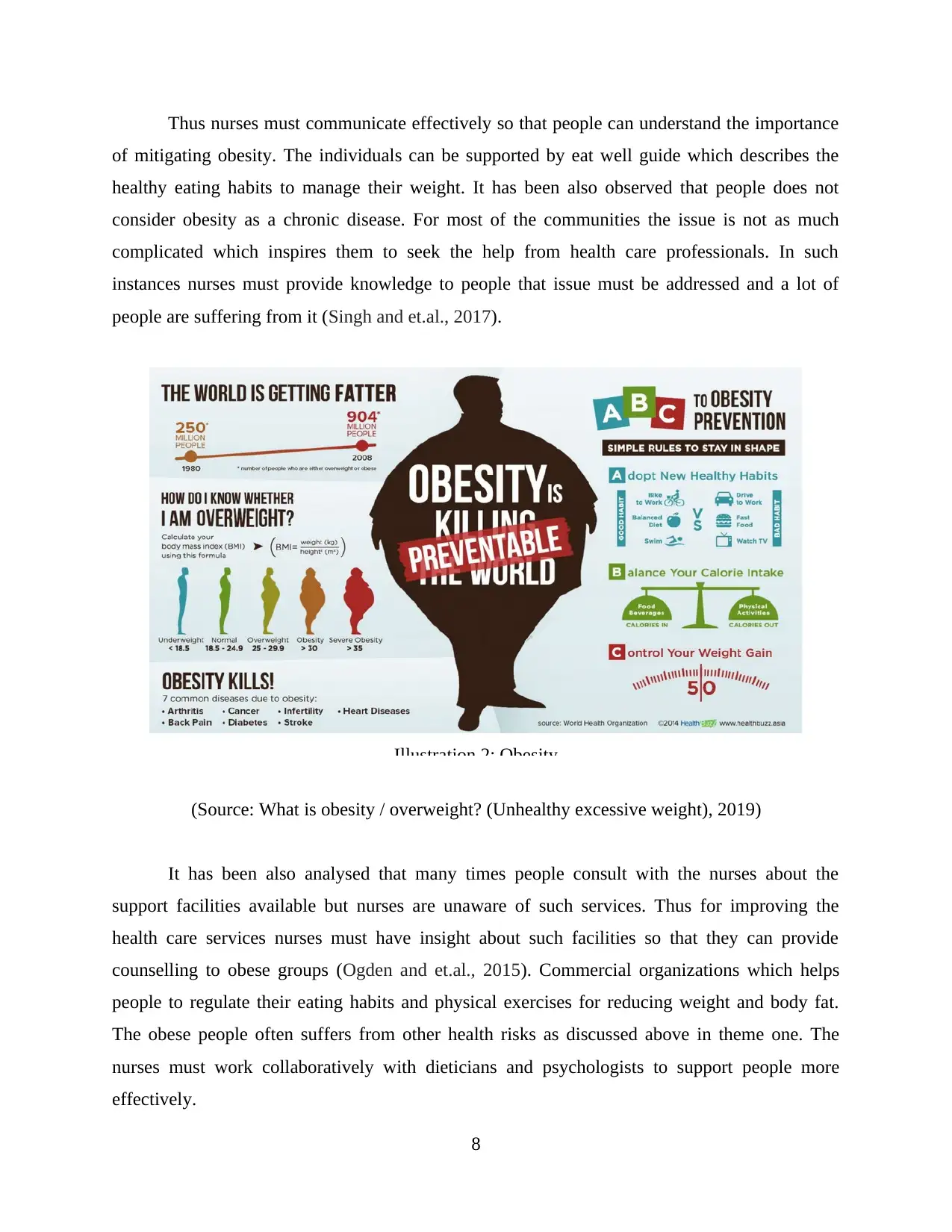
Thus nurses must communicate effectively so that people can understand the importance
of mitigating obesity. The individuals can be supported by eat well guide which describes the
healthy eating habits to manage their weight. It has been also observed that people does not
consider obesity as a chronic disease. For most of the communities the issue is not as much
complicated which inspires them to seek the help from health care professionals. In such
instances nurses must provide knowledge to people that issue must be addressed and a lot of
people are suffering from it (Singh and et.al., 2017).
(Source: What is obesity / overweight? (Unhealthy excessive weight), 2019)
It has been also analysed that many times people consult with the nurses about the
support facilities available but nurses are unaware of such services. Thus for improving the
health care services nurses must have insight about such facilities so that they can provide
counselling to obese groups (Ogden and et.al., 2015). Commercial organizations which helps
people to regulate their eating habits and physical exercises for reducing weight and body fat.
The obese people often suffers from other health risks as discussed above in theme one. The
nurses must work collaboratively with dieticians and psychologists to support people more
effectively.
8
Illustration 2: Obesity
of mitigating obesity. The individuals can be supported by eat well guide which describes the
healthy eating habits to manage their weight. It has been also observed that people does not
consider obesity as a chronic disease. For most of the communities the issue is not as much
complicated which inspires them to seek the help from health care professionals. In such
instances nurses must provide knowledge to people that issue must be addressed and a lot of
people are suffering from it (Singh and et.al., 2017).
(Source: What is obesity / overweight? (Unhealthy excessive weight), 2019)
It has been also analysed that many times people consult with the nurses about the
support facilities available but nurses are unaware of such services. Thus for improving the
health care services nurses must have insight about such facilities so that they can provide
counselling to obese groups (Ogden and et.al., 2015). Commercial organizations which helps
people to regulate their eating habits and physical exercises for reducing weight and body fat.
The obese people often suffers from other health risks as discussed above in theme one. The
nurses must work collaboratively with dieticians and psychologists to support people more
effectively.
8
Illustration 2: Obesity
Paraphrase This Document
Need a fresh take? Get an instant paraphrase of this document with our AI Paraphraser
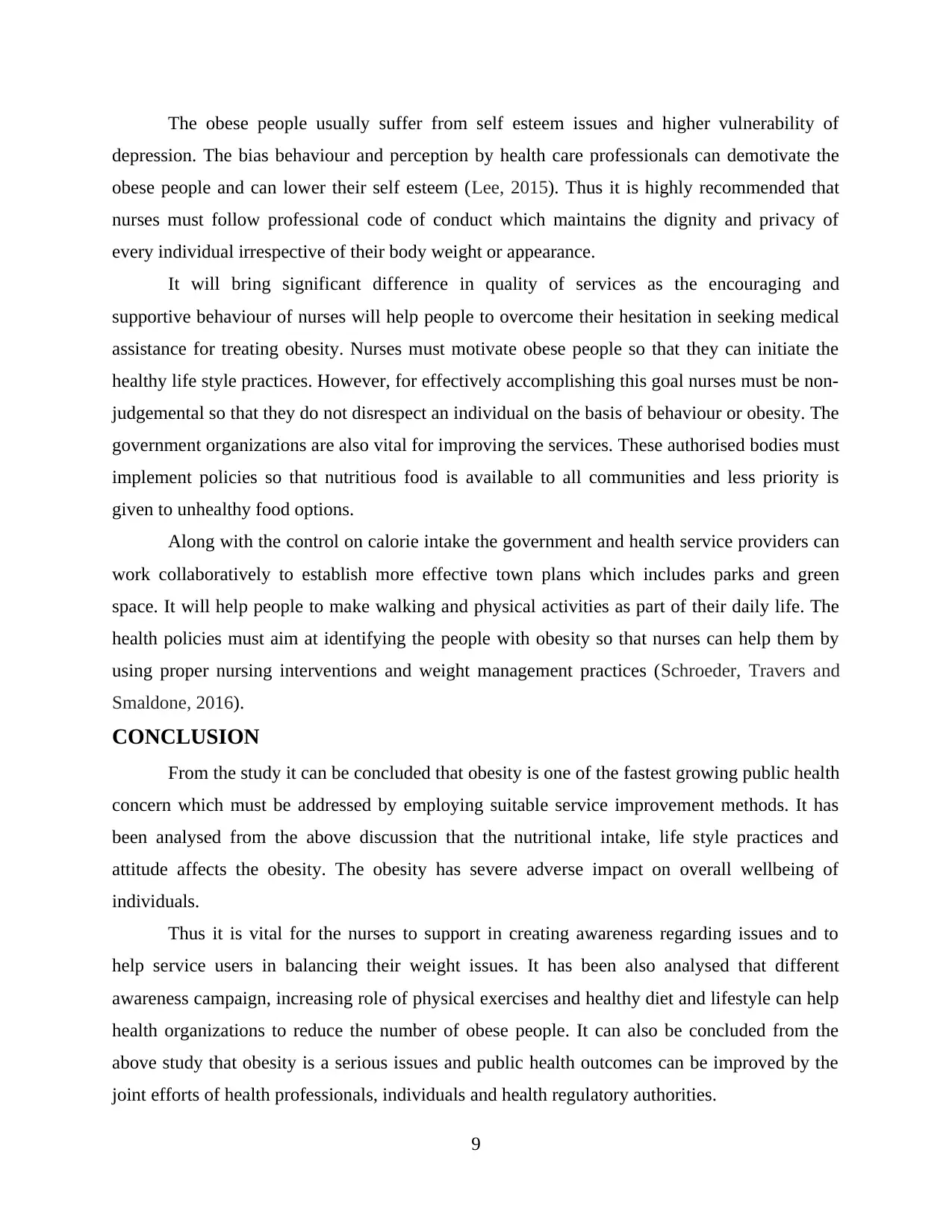
The obese people usually suffer from self esteem issues and higher vulnerability of
depression. The bias behaviour and perception by health care professionals can demotivate the
obese people and can lower their self esteem (Lee, 2015). Thus it is highly recommended that
nurses must follow professional code of conduct which maintains the dignity and privacy of
every individual irrespective of their body weight or appearance.
It will bring significant difference in quality of services as the encouraging and
supportive behaviour of nurses will help people to overcome their hesitation in seeking medical
assistance for treating obesity. Nurses must motivate obese people so that they can initiate the
healthy life style practices. However, for effectively accomplishing this goal nurses must be non-
judgemental so that they do not disrespect an individual on the basis of behaviour or obesity. The
government organizations are also vital for improving the services. These authorised bodies must
implement policies so that nutritious food is available to all communities and less priority is
given to unhealthy food options.
Along with the control on calorie intake the government and health service providers can
work collaboratively to establish more effective town plans which includes parks and green
space. It will help people to make walking and physical activities as part of their daily life. The
health policies must aim at identifying the people with obesity so that nurses can help them by
using proper nursing interventions and weight management practices (Schroeder, Travers and
Smaldone, 2016).
CONCLUSION
From the study it can be concluded that obesity is one of the fastest growing public health
concern which must be addressed by employing suitable service improvement methods. It has
been analysed from the above discussion that the nutritional intake, life style practices and
attitude affects the obesity. The obesity has severe adverse impact on overall wellbeing of
individuals.
Thus it is vital for the nurses to support in creating awareness regarding issues and to
help service users in balancing their weight issues. It has been also analysed that different
awareness campaign, increasing role of physical exercises and healthy diet and lifestyle can help
health organizations to reduce the number of obese people. It can also be concluded from the
above study that obesity is a serious issues and public health outcomes can be improved by the
joint efforts of health professionals, individuals and health regulatory authorities.
9
depression. The bias behaviour and perception by health care professionals can demotivate the
obese people and can lower their self esteem (Lee, 2015). Thus it is highly recommended that
nurses must follow professional code of conduct which maintains the dignity and privacy of
every individual irrespective of their body weight or appearance.
It will bring significant difference in quality of services as the encouraging and
supportive behaviour of nurses will help people to overcome their hesitation in seeking medical
assistance for treating obesity. Nurses must motivate obese people so that they can initiate the
healthy life style practices. However, for effectively accomplishing this goal nurses must be non-
judgemental so that they do not disrespect an individual on the basis of behaviour or obesity. The
government organizations are also vital for improving the services. These authorised bodies must
implement policies so that nutritious food is available to all communities and less priority is
given to unhealthy food options.
Along with the control on calorie intake the government and health service providers can
work collaboratively to establish more effective town plans which includes parks and green
space. It will help people to make walking and physical activities as part of their daily life. The
health policies must aim at identifying the people with obesity so that nurses can help them by
using proper nursing interventions and weight management practices (Schroeder, Travers and
Smaldone, 2016).
CONCLUSION
From the study it can be concluded that obesity is one of the fastest growing public health
concern which must be addressed by employing suitable service improvement methods. It has
been analysed from the above discussion that the nutritional intake, life style practices and
attitude affects the obesity. The obesity has severe adverse impact on overall wellbeing of
individuals.
Thus it is vital for the nurses to support in creating awareness regarding issues and to
help service users in balancing their weight issues. It has been also analysed that different
awareness campaign, increasing role of physical exercises and healthy diet and lifestyle can help
health organizations to reduce the number of obese people. It can also be concluded from the
above study that obesity is a serious issues and public health outcomes can be improved by the
joint efforts of health professionals, individuals and health regulatory authorities.
9

10
⊘ This is a preview!⊘
Do you want full access?
Subscribe today to unlock all pages.

Trusted by 1+ million students worldwide
1 out of 15
Related Documents
Your All-in-One AI-Powered Toolkit for Academic Success.
+13062052269
info@desklib.com
Available 24*7 on WhatsApp / Email
![[object Object]](/_next/static/media/star-bottom.7253800d.svg)
Unlock your academic potential
Copyright © 2020–2025 A2Z Services. All Rights Reserved. Developed and managed by ZUCOL.





